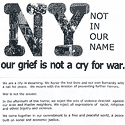war
Good in School
Last month, GOOD posted this write-up about an increasing number of graduate design programs focused design for social impact. There’s more to say on this, but in the meantime, no need to wait for grad school — why not start a student-run Design for America studio on your own campus? DfA’s previous projects focus on childhood diabetes, hospital-acquired infections, cafeteria water conservation, and children with post-war stress.
And that doesn’t even include veterans.
Art vs Empire

The Center for the Study of Political Graphics has two new online exhibitions: MasterPeaces, High Art for Higher Purpose and Art Against Empire, Graphic Responses to U.S. Interventions Since World War II. Both are chock full of oppositional graphic goodness (and one of my poster designs, too!)
Sir! No Sir!
 From Peter Linebaugh in CounterPunch:
From Peter Linebaugh in CounterPunch:
“On the 11th hour of the 11th day of the 11th month the Great Powers of the World signed the armistice laying down arms after four years of the bloodiest war in history. That was 1918.
Now, we call it Veteran’s Day.
What caused the armistice was the refusal of soldiers to fight. They refused ‘to go over the top’ anymore. In Russia, France, England, Italy they refused to participate in the slaughter which had begun in 1914.
What we learn from Armistice Day is that the soldier is the front line of the peace movement.”
GI refusal also helped end the war in Vietnam, and it’s spreading in Iraq and Afghanistan, too, encouraged by veterans speaking out.
Decision Points
Decisions, decisions. True Crime or Science Fiction & Fantasy? Marketing & Advertising?
Where would you shelve George W. Bush’s memoir?

The Biggest Polluter

Each year Project Censored compiles a list of 25 urgent stories that are grossly underreported. But on this year’s chilling list, the scale of this one is just staggering:
“The US military is responsible for the most egregious and widespread pollution of the planet, yet this information and accompanying documentation goes almost entirely unreported. In spite of the evidence, the environmental impact of the US military goes largely unaddressed by environmental organizations and was not the focus of any discussions or proposed restrictions at the recent UN Climate Change Conference in Copenhagen. This impact includes uninhibited use of fossil fuels, massive creation of greenhouse gases, and extensive release of radioactive and chemical contaminants into the air, water, and soil.
The extensive global operations of the US military (wars, interventions, and secret operations on over one thousand bases around the world and six thousand facilities in the United States) are not counted against US greenhouse gas limits.…
As it stands, the Department of Defense is the largest polluter in the world, producing more hazardous waste than the five largest US chemical companies combined. Depleted uranium, petroleum, oil, pesticides, defoliant agents such as Agent Orange, and lead, along with vast amounts of radiation from weaponry produced, tested, and used, are just some of the pollutants with which the US military is contaminating the environment.”
The horror goes on and on and on.
And it makes me think a lot of sustainable designers may be fighting the wrong war.
 In June I wrote about Conflict Kitchen, a pop-up, take-out restaurant in Pittsburg that only serves cuisine from countries that the United States is in conflict with. In October, Kubideh Kitchen will go out of business and change identities to highlight and provoke discussion around Afghan culture. The organizers have started a Kickstarter campaign to raise $4,000 by the end of September. Donations will go towards the creation Bolani Pazi, which will serve Afghan food wrapped in a custom-designed wrapper printed with Afghan perspectives and opinions. Pledges of $15 or more will receive copies of the stylish (and informative) food wrapper designs from both Kubideh Kitchen and Bolani Pazi.
In June I wrote about Conflict Kitchen, a pop-up, take-out restaurant in Pittsburg that only serves cuisine from countries that the United States is in conflict with. In October, Kubideh Kitchen will go out of business and change identities to highlight and provoke discussion around Afghan culture. The organizers have started a Kickstarter campaign to raise $4,000 by the end of September. Donations will go towards the creation Bolani Pazi, which will serve Afghan food wrapped in a custom-designed wrapper printed with Afghan perspectives and opinions. Pledges of $15 or more will receive copies of the stylish (and informative) food wrapper designs from both Kubideh Kitchen and Bolani Pazi.Update 9/25/10: Success! $4,178 raised!
 How startling seeing some of those old demo flyers from nearly 10 years ago. Those were emotional days on the streets of New York, trying to help where needed and to reign in the war machine.
How startling seeing some of those old demo flyers from nearly 10 years ago. Those were emotional days on the streets of New York, trying to help where needed and to reign in the war machine. Breakdown Press has just published The Peace Posters, a 32-page broadsheet newspaper which unfolds to 30 posters — and is available for free. To obtain copies for bedroom walls, workplaces, street poles, community notice boards, shopfronts and schools, email distro@breakdownpress.org with your postal address and how many copies you wish to receive. The collection also includes one of my posters.
Breakdown Press has just published The Peace Posters, a 32-page broadsheet newspaper which unfolds to 30 posters — and is available for free. To obtain copies for bedroom walls, workplaces, street poles, community notice boards, shopfronts and schools, email distro@breakdownpress.org with your postal address and how many copies you wish to receive. The collection also includes one of my posters.Memorial Day

Source: http://www.armytimes.com/news/2010/04/military_veterans_suicide_042210w/
While there may not be so many “unknown soldiers” any more, it seems like there are more and more forgotten ones in our midst.

